The marketing sphere is constantly evolving, but if there’s an adage that rings endlessly true, it’s that content is king. Content marketing has transformed the ways in which businesses engage with consumers. From magazine features and television advertisements to social media memes and beyond, the written word has always been instrumental in enticing curious readers and converting them into leads.
Enter: SEO copywriting.
In the digital age—and as we continue to stray further from physical print—the content marketing game evolves on its own accord. SEO copywriting has become an art separate from traditional copywriting, and its intent is to align with the ever-changing algorithms of search engines.
As a marketer, understanding when to utilize one form of writing versus another is crucial in creating campaigns that convert. But what is the difference between traditional copywriting and SEO copywriting? How does one create content that ranks? Read on to find answers to your burning questions.
- Chapter 1: SEO Copywriting, Explained
- Chapter 2: Keywords
- Chapter 3: Formatting
- Chapter 4: Readability
- Chapter 5: Search Engine Optimization Copywriting Best Practices
- Chapter 6: FAQs
Watch A Video On SEO Copywriting And Long-Form Content
Short on time? Start with this video, or read the full guide below:
Chapter 1: SEO Copywriting, Explained
What is SEO Copywriting (& How Is It a Unique Form of Copywriting)?
Before we get into the “how-to,” it’s important that we first go over the “what.” As in: What is SEO copywriting?
SEO, or search engine optimization, is an online marketing technique that maximizes your website’s presence in the search results.
Meanwhile, copywriting is a data-driven form of writing whose goal is to influence someone to take a specific action. Usually, that action is to buy a product or service, but any sort of conversion could come into play. Brand awareness is also a big goal of copywriting.
SEO copywriting blends the best of both worlds. It produces content that not only ranks well in the search results but also convinces readers that they should take action.
Is all copywriting considered search engine optimization copywriting?
Technically, no. Just look at billboards and other forms of experiential marketing that feature copywriting and aren’t found on search engines. Both copywriting and SEO copywriting are methods of putting words on a page, but they serve two distinct purposes:
- Copywriting aims to educate and persuade the buyer into conversion.
- SEO copywriting aims to create optimized content that targets specific keywords and increases a brand’s relevancy.
But in the digital world, businesses can’t escape SEO even if they wanted to. That makes the two largely inseparable.
To create content that ranks, drives leads, and provides searchers with immediate answers to their Google queries, you must combine both writing tactics. Now, how do you do that?
Google’s top-ranking factors include, but are not limited to:
- Page speed
- Links and backlinks
- Keyword targeting
- Title and header tags
- Metadata
- URL structure
- Content quality (including readability and formatting)
Keep scrolling through the chapters to get a rundown of the most integral parts of SEO copywriting, including optimized keywords, UX-friendly formatting, and readability. The end goal is to organically elevate a site’s Google rankings, provide answers to keyword queries, and convert visitors into leads.
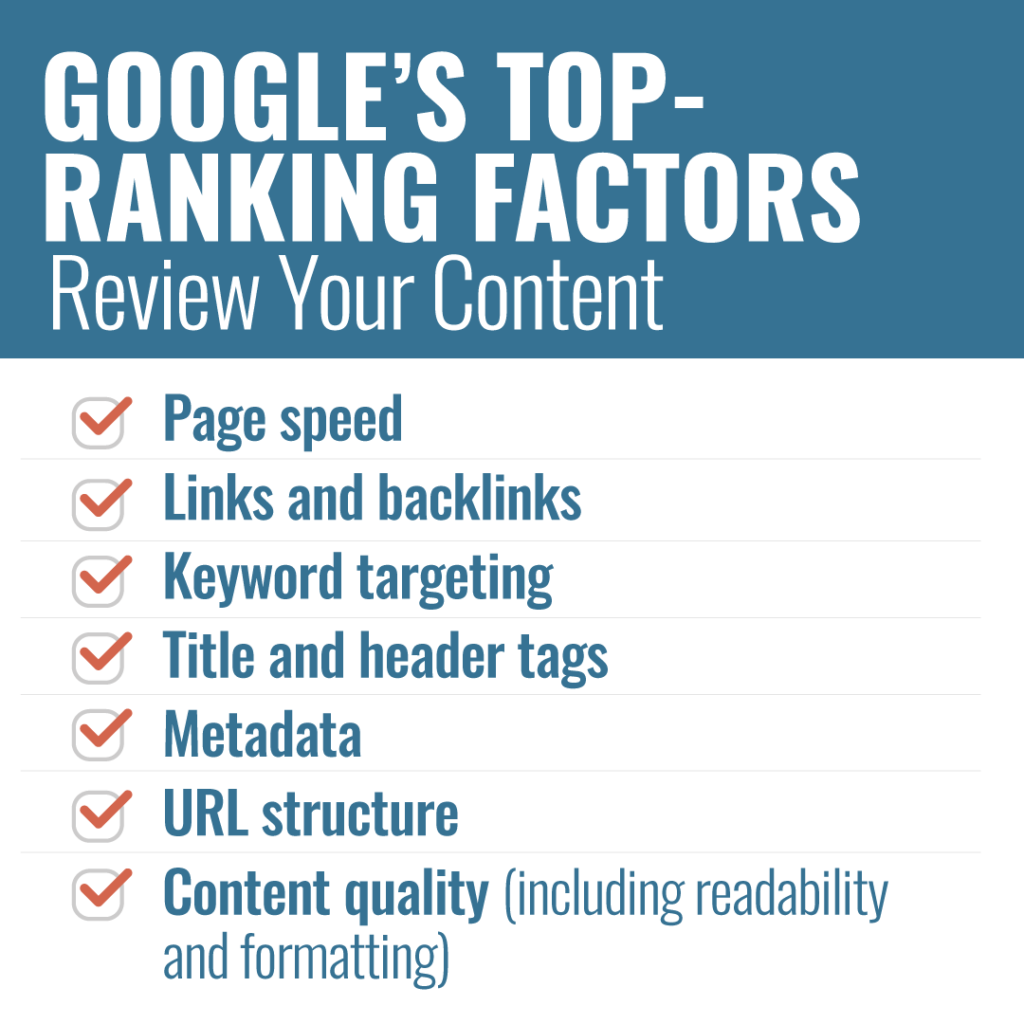
Google’s Top Ranking Factors
Chapter 2: Keywords for SEO Copywriting
Keywords Are the First Pillar of Search Engine Optimization Copywriting
It all begins with a search term.
SEO keywords are the target words and phrases that make it possible for web users to find your site via search engines.
Let’s say your business sells sustainably-made apparel. “Sustainable clothing” would likely be a common target keyword to include across your web copy. SEO keywords essentially define what your copy is about.
The first thing you need to do is to come up with keywords. The good news is that some of the keywords related to your business model will be obvious. The bad news is that many of those obvious keywords are likely to be very competitive.
That means other businesses in your space will try to rank for those same keywords as well. You’ll have trouble getting to the top of the SERPs with a competitive keyword.
However, you can still look for keywords that aren’t very competitive. For that, you should use a tool like SEMRush or SpyFu.
Using tools like SEMRush, you can search for related keywords to use.
I put in a bunch of keywords. My content will rank now, right?
Nope. There is much more that goes into SEO copywriting than merely packing your copy with keywords. In fact, keyword stuffing can kill your SEO.
Keyword stuffing is a tactic in which a writer fills up copy with the same target term in hopes of creating higher relevancy to yield higher rankings. Google hates this and could punish the site with a search penalty.
When it comes to optimizing your keyword density, stick to 0.5–2%, or 1 appearance per 200 words to 2 appearances per 100 words. Experts say this range is ideal.
Incorporate similar phrases that are slightly different from your target keyword. Semantic variation is the art of slightly rearranging keywords. For example, let’s say your target keyword is “black shoes for women.” Using “women’s black shoes” is considered a semantic variation. If your target keyword is “San Diego home buying,” “home buying in San Diego” is a valid semantic variation.
Whatever you do, work to make your page the best resource for that term. Keep search intent in mind, because the user’s intent behind the query is everything.
Keyword Best Practices
Just to recap, here are some best practices you can use when researching and optimizing for SEO keywords:
- Use keywords right away: The primary keyword should appear within the title and the first 100 words.
- Don’t keyword stuff: Keep keyword density below 2%. Mix in semantic variations of target keywords to add clarity and diversity.
- Include the keyword in the URL itself: That means if your keyword is “blue jeans,” then that phrase should appear in the URL with a hyphen between each word (instead of a space).
- Include the keyword in the meta description tag: That’s the tag that Google uses to show the description of the website contents in the search results. Google will also parse that tag to determine if a specific search term is relevant to the contents of the article.
- Break up your content with subheadings: Use the keyword in the subheadings as much as possible. Just be sure you don’t “force” the keyword into a place it doesn’t belong or you could do more harm than good.
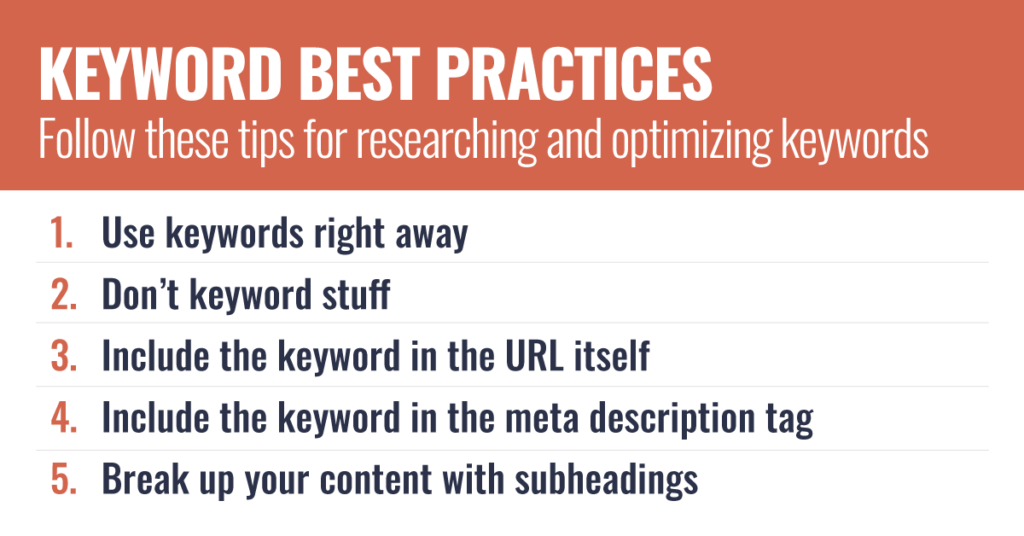
Keyword Best Practices
Chapter 3: Formatting
Formatting Makes or Breaks Your Page
The structure, or outline, of your longer-form content begins with the skeletal formatting. When writing blog copy, headings and subheadings alone should provide insight into what questions you’ll be answering, what topics you’ll be discussing, and any major takeaways readers can expect.
Think of your own experience surfing the web. When you’re looking for a quick answer to your Google search, odds are pretty likely that you’ll skim the page Google presents first (if there isn’t already an answer box feature for your query). Unless you’re looking for an in-depth tutorial or conducting serious research, you probably won’t take the time to read the entire article.
You’re not alone in this. According to a Webdam study, 81% of people only skim the content they read online. Plus, Google can now send users directly to certain parts of a piece of content, often guided by the heading it falls under.
When working on your SEO copywriting skills, it’s important to strategically create skimmable copy that provides the reader with the information they need in digestible chunks. Formatting plays a crucial role in accomplishing this, especially if you’re aiming to increase your reader’s time on-page.
You can do skeletal formatting by using headings and subheadings that provide insight into what questions you’ll answer in the piece. Add subheadings on related topics to get the most bang for your page (find related search terms at the bottom of the page or use the “people often ask” section on the search engine results page). Place the keywords correctly to ensure search engines—and readers—know what you’re talking about.
Add visual elements to help guide the formatting, and be sure to provide immediate answers (even if you go more in-depth further down the page).
Formatting Best Practices:
- Optimize your headers and subheaders: Headers and subheaders should feature your target keywords. Not only does this help meet your keyword density quota, but optimized headings give Google more context for your page. Headers and subheaders should serve as the skeleton for your piece. As such, each header must serve a purpose, not just fluffy text to break up your words. Think of your subheaders as additional opportunities to snag a featured snippet result for your target keyword.
- Provide immediate answers: If your header is a question, the text that follows should immediately provide a comprehensive, digestible answer. Google is more likely to reward straightforward and understandable answers than answers clouded in fluff.
- Add visual elements: Custom graphics, stock photos, videos, and banners are all excellent ways to break up your text. When selecting visuals to use, make sure they are relevant to your post and enhance the on-page user experience rather than muddle it.
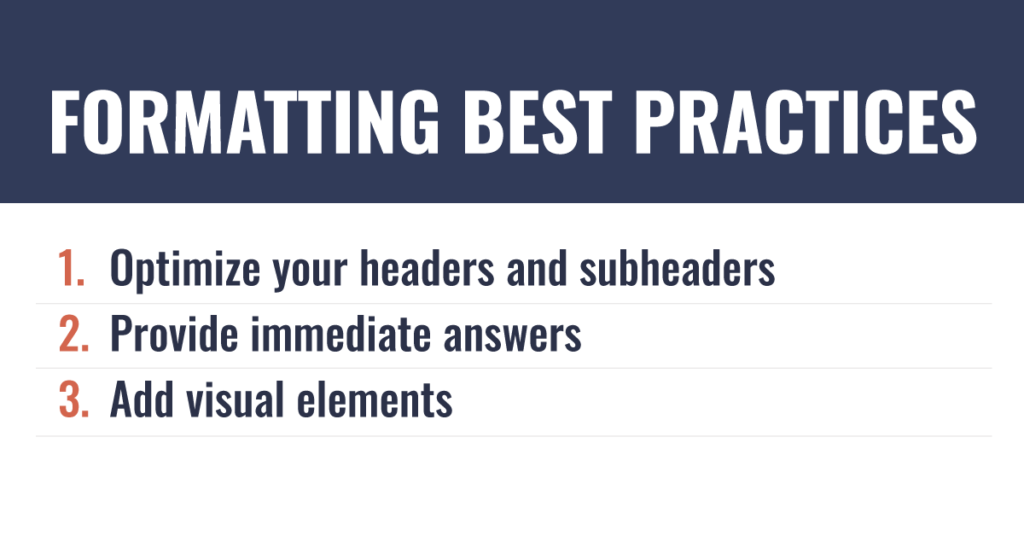
Formatting Best Practices
Chapter 4: Readability for SEO Copywriting
Without Readability, You Won’t Rank
Formatting and readability go hand in hand.
Readability is one of the most important factors to consider when writing any type of copy.
Think about yourself as a reader. When you are searching on the web, are you more likely to spend time with a result that features shorter, easier-to-understand paragraphs than you would with longer, more complex ones?
The answer is obvious: It’s the better-outlined copy with shorter paragraphs.
Why Does Readability Matter?
Readability matters because user experience matters. Users aren’t looking for long-winded answers to their questions. Hard-to-read content diminishes user experience. It also results in higher bounce rates (a metric that measures how quickly users click off the page).
How Does Readability Affect SEO?
SEO copywriting is all about proving to Google that your content is correct, digestible, and worthy of those top-ranking spots. Readability accounts for all of the above. Content that is clear, concise, and easily navigated ranks better.
Ultimately, simplicity and straightforwardness are best. Let’s dive into what that actually looks like.
Readability Best Practices
- Keep it simple: Where possible, avoid complex words, phrasing, and challenging jargon that the average searcher would have to complete another Google search to understand.
- Keep paragraphs short: As a general rule of thumb, optimized copy should aim to maintain paragraphs at or below six sentences. The goal is to engage the reader with bite-sized information. You don’t want to overwhelm them or lose their attention. Always look back at your work and ask yourself, “Would I read this?” and “How easily does this content answer my query?”
- Use bold text: Most searchers are looking for immediate answers — and in an article that’s rather lengthy, scrolling to find an answer can be tedious. Bolded text is a great way to highlight the most important information searchers are looking for.
- Use bulleted and numbered lists: Bulleted and numbered lists are excellent ways to break up chunks of text, especially when covering several different talking points or listing out multiple tips, features, steps, pros & cons, etc.
- Take advice from ranking content: What does a highly readable piece of content look like?
- Balance data and facts: One of the keys to producing great SEO copy is to ensure that it appears authoritative. One of the ways that you do that is by citing facts, figures, and statistics from reputable sources. Don’t over-stuff your content with numbers and metrics. Use features like infographics, bullets, and other readability hacks to keep your content easy-to-read while still giving it depth.
- Keep your content at a 6th–8th grade reading level: Most general content should be easy enough to read that someone with a 6th–8th grade reading level could easily understand it. Use tools like Hemingway Editor to make sure you’re not going overboard with the fancy synonyms.
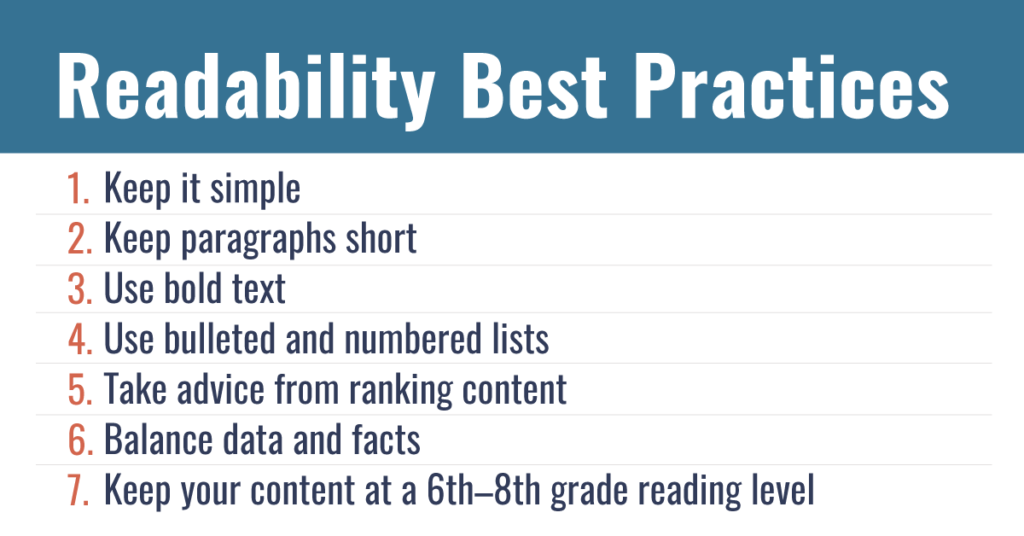
Readability Best Practices
Chapter 5: More SEO Copywriting Best Practices
Best Practices to Improve Your Search Engine Optimization Copywriting from the Start
- Once you have your keyword(s), research your subject thoroughly online. You want to create an authoritative source for whatever it is you’re writing about.
- Cover topics suggested in the related searches section of a search engine results page for SEO copywriting. Incorporate similar keywords in your text, and make sure you place them in headings, subheadings, and in optimized locations throughout the page.
- First impressions matter. Look at SEO copywriting examples that rank and note what sparks your interest—and what sends you running.
- Avoid mentioning competitors. Advertisements hardly ever mention competitors. You should follow that example in your own marketing efforts. If you mention a competitor, you’re basically giving that business a free ad. You’re boosting the brand-name awareness of another company. Instead, you should focus on boosting your own brand.
- Provide a clear call to action (CTA). A good CTA is a button that stands out because it’s 1) large and 2) in a contrasting color. Beyond that, the text on the button should spell out exactly what action will occur if the visitor presses it. Leave out any ambiguity on the CTA and you’ll find that your conversion rate improves.

Example of a CTA
- Answer questions and objections in your SEO writing. This reduces the need for people to find answers elsewhere and keeps them on the page.
- Prioritize long-form content. Pages with 1,200–1,500 words perform better in search results.
Chapter 6: FAQs About SEO Copywriting
FAQs About Search Engine Optimization Copywriting
1. Can I Hire Somebody to Do SEO Copywriting?
Absolutely.
If you’re uncomfortable with copywriting, you can (and should) outsource the task to a qualified professional.
In fact, you can make a strong case that it’s typically a great idea to let somebody else do your copywriting. That way, you can focus more on the mission of your business.
Keep in mind: A good copywriter isn’t cheap. You’ll have to spend some cash if you want quality work. But there are plenty of examples of businesses that hire copywriters and see a positive return.
2. What’s the APP Method in SEO Copywriting?
Brian Dean popularized the APP method, which stands for Agree, Preview, Promise.
Start by writing a paragraph that people will agree with. Usually, you’ll do that by defining a problem that they’re experiencing.
Then, in the next paragraph, make them a promise. For example, tell them they can overcome their problem by following a few steps.
In the third paragraph, offer a preview. Start with something like “In this article, I’ll explain how you can…”
In the rest of the article, fulfill the promise you made in the second paragraph.
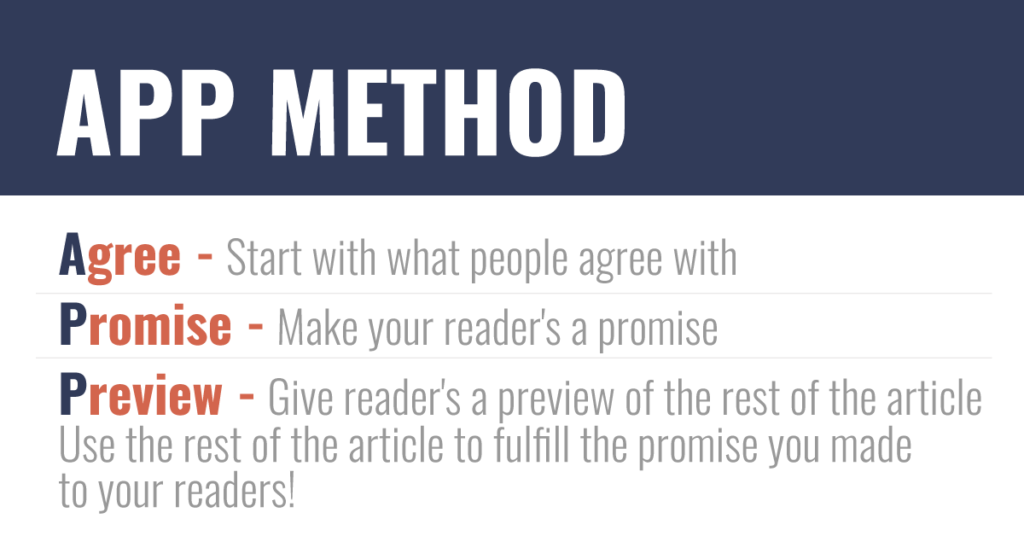
APP Method for SEO Copywriting
3. What Do Titles and Descriptions Have to Do With SEO Copywriting?
They’re important because they give people the first impression of your content.
For starters, titles appear in the search results. Sometimes descriptions appear in the search results as well, but not always.
That’s why you should do two things:
- Optimize your titles and descriptions for keywords related to your content. That way, people will find your website when they use search terms related to your niche.
- Make sure your title and description accurately reflect the content of the article. Otherwise, people will bounce away when they see that the article isn’t related to their interests.
4. How Do I Find SEO Keywords?
Choose a selection of topics that align with your brand. Pretend those topics are buckets and fill them with keywords. Select groups of keywords that you can use on your website to drive traffic (including landing pages and blogs).
Use tools like SEMrush and SpyFu to help you find keywords that aren’t overly competitive and you can rank with.
Learn more in Chapter 2: Keywords for SEO above.
5. How Many Keywords Should I Use for SEO Copy?
Each page should have a primary keyword and potentially a couple of secondary keywords to accompany it. You can also use keyword variants or semantic keywords. You don’t want to use too many keywords or use the keywords you have too many times on the page (this is keyword stuffing). Keep your density at 0.5–2% of the on-page text.
Bottom Line: Content (& SEO Copy) Is King
Without strong marketing copy, there is nothing that connects you to your customers.
Without strategic SEO copy, your web presence will flounder.
Today’s marketing world is cutthroat and distinguishing yourself from the competition begins with the sentences you string together. By heeding best practices, using SEO keywords and data to your advantage, and sprinkling in some creative genius through your copywriting, your content marketing efforts will shine.
